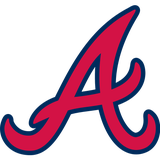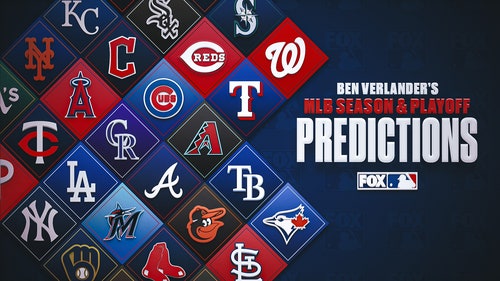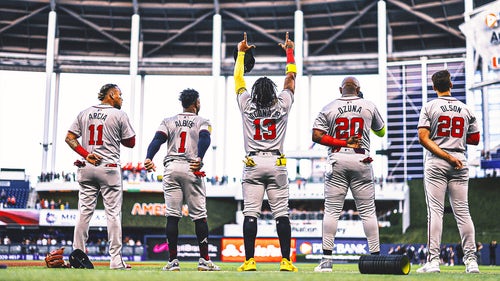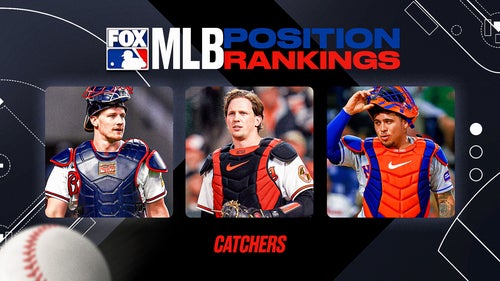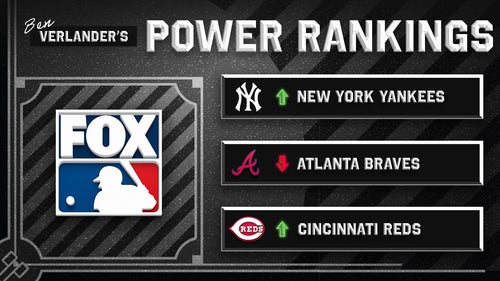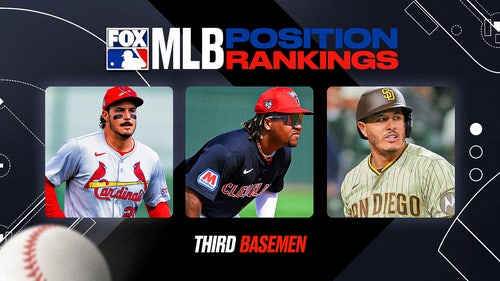
A Look At the High School Class In the 2017 MLB Draft
January 14, 2017; Tempe, AZ, USA; High school pitcher Hunter Greene during the USA Baseball sponsored Dream Series at Tempe Diablo Stadium. Mandatory Credit: Mark J. Rebilas-USA TODAY Sports
MLB Draft season is in full swing. Who are the high school talents to be aware of, and what is the make up of the high school class this season?
Our MLB coverage at Call to the Pen is fairly well-balanced, but in an effort to give you better breadth and depth of coverage of minor league baseball, we will begin a number of weekly posts.
The first will examine the big news items along with the top performers in the minor leagues each Monday. Tuesday will bring a review of the weekend highlight series. Wednesday will bring draft news and college baseball news until that is complete. Thursday will preview the weekend series of note in minor league baseball to watch. Friday will feature a new series, "The Video Room", where CTTP contributor Benjamin Chase will examine one game from the week from a scouting perspective and break down the game.
Scouting reports will be scattered throughout the week and weekends as well, so keep on the lookout for those as well. As always, if there is anything you would like to see covered more thoroughly here at CTTP, let us know in the comments section below!
Today, we will look at the high school draft class for the 2017 MLB draft. With many places beginning to get more into mock drafts and into deeper scouting reports, the top rated prospects are coming out.
We are starting to see senior year performance for the high school class sort out the true risers for the MLB draft and some guys who perhaps are falling already in the process.
Top Guys
While Hunter Greene is the top overall talent, and he'd likely be a top 15-20 choice as a shortstop, he's certainly being considered as a pitcher, not a hitter by the majority of teams.
Right now the top hitting prospect is between outfielder Austin Beck of North Carolina and infielder/outfielder Royce Lewis of California.
Beck is a guy who exploded onto the national scene after his sophomore year with a rare blend of athleticism and raw talent before suffering a torn ACL his junior season and missing many of the showcase events last summer. Beck has shown himself to be healthy this spring, however, and his stock has been quickly rising in part, to a very likely top 5 selection overall.
Lewis has been moving the opposite direction as the spring goes on. Over the summer, Lewis tried out the outfield in a number of showcases after being primarily an infielder previously. While he's got the athleticism to be a solid center/left fielder, he hasn't really developed the natural instincts at the position, leading to some question where he'll play. However, the biggest question this spring has been the absolute crater in Lewis' bat. He certainly has time to finish strong, but so far he's not hit well.
Coming into the season both Nick Pratto and Jordan Adell were considered possible two-way prospects, with legit talent off of the mound that could play up and present bat talent that could certainly lead to a high draft spot.
Pratto is a lefty-hitting first baseman and pitcher from California that has done nothing but show positive things all spring. Every review I've heard on his bat this spring has been that he's even better than in showcase season, calling his bat possibly the highest floor bat in the high school class. While Pratto is not at a defensive premium position, if his bat is able to play, he could certainly follow the path of fellow high school first baseman Eric Hosmer in going top 5 overall in the draft (Hosmer went #3 out of high school in Florida).
Adell is an outfielder from Ohio with an arm that many felt was very projectable, and therefore, considered him a possible two-way threat. As he's come into his senior season, he's really shown the offensive side of the ball is more his forte. Adell is likely to be going high in the draft due to his pure athleticism in the outfield, but he has a bat that may have some of the highest level of ceiling in the entire draft class, though he's not even the best athlete in his own sibling group, as his sister Jessica is able to run track and play softball for Louisville currently.
Catchers
High school catchers are often a difficult market to navigate in the draft as many fizzle out before reaching the majors if they stay at catcher, while most move off of the position. Interestingly, many high school infielders or pitchers end up moving behind the plate and turning into quality catchers in pro ball. That said, there is an athletic group of catchers in this year's class.
The top pure catcher in the class is M.J. Melendez, from Florida. His father, Mervyl Melendez, is the coach at Florida International, which is where he has his college commitment to no surprise. He has a power arm behind the plate and also offers some interesting power from the left side at the plate as well.
Many view Hagen Danner as a pitcher. Others view the California prep as a future infielder rather than a catcher, but his high level of athleticism has many believing he could be a very solid defensive catcher. Danner has budding power and a good feel for the strike zone as a hitter and a low-90s fastball with excellent movement off the mound. Many see him as a player that could be a wild card in the draft.
Georgia catcher Luis Campusano has received a number of comments about having a perfect catcher's lower half to his build, and he displays all the right traits you'd want behind the plate with excellent movement and arm strength behind the plate. Campusano does display some load issues in his swing that could mean some issues adjusting to pro ball, but when he makes contact, it's powerful contact, so there could be a future two-way catcher here.
Florida prep Sam McMillan has shown excellent feel for the game behind the plate, getting rave reviews for his receiving and ability to work with pitchers. Offensively, he has a bit of a rigid swing, but when he does cut loose, he can drive for gap power.
Corner Infielders/DHs
Alex Toral has been noted for his monster power for some time. The Florida native has good patience and has shown in showcases the ability to lay off pitches to take a walk, but also to pounce on a pitch he likes and generate tremendous carry on the ball. Toral has played some outfield as well.
Texan Ryan Vilade won the home run derby at the Under Armour All-American game last summer and has a big pull-power approach. He has a solid arm at third base with average instincts and hands at the position.
Two-sport athlete Terry Fuller was a bruiser on the football field as a defensive end for his Georgia high school, and now he's bruising baseballs on the field. Not a lot of physical projection to Fuller, but there's obvious power in his profile.
While his swing isn't the prettiest, Nick Egnatuk showed the ability to drive the ball with authority to all fields. The New Jersey native has the arm to stick at third, but his range will likely need to tick up to stay there as a pro.
Tim Elko has the frame that could force him across the infield from 3B to 1B at 6'4″ and 225 pounds already, but the Florida lefty uses his frame to generate impressive power. However, his offensive game is more impressive in that he really recognizes pitches well and can use the whole field at his physical size.
Middle Infielders
While many feel Mark Vientos will end up at third base long-term, he has the skills to handle shortstop. Vientos has been profiled similarly to Manny Machado, in that he'd be an elite third baseman defensively, but could handle short. What will certainly lead to his drafting regardless of his position is Vientos' exceptional bat control that leads to an excellent hit tool. Vientos has tremendous speed and raw power that could develop well with that hit tool. He has been rumored quite high in the draft, and it'd not surprise if he ended up in the top 10.
While not the hitter that Vientos is, there is no equal to Nick Allen defensively in this class. Allen is a California shortstop who has a plus to plus-plus arm with elite range, hands, and instincts up the middle. Scouts are more split on his bat. He did take up switch hitting this off-season, and many have liked the results. At his small (5'8, 160ish) frame, he's not likely to out-grow the middle of the infield, but his bat will determine where a team is comfortable with him.
Canadian Adam Hall has shown his defensive chops up the middle, though he projects best at second base. Offensively, he has swing work that needs to be done, but he does have good pitch recognition and the ability to turn on a pitch and drive the ball well.
A preseason All-American per Baseball America, Brady McConnell came into the season with a high grade that many thought could launch him to the top of the draft class. Instead, he's struggled this spring, and many feel he may have fallen out of even the second round, let alone the first round. McConnell is a guy who has excellent offensive raw tools that could produce gap power now with double-plus raw speed. He has the frame to develop more over-the-fence power. He has been a guy most feel should stick up the middle, but if he filled out, he does have a frame that would work at third base as well.
Long and lean, Chris Seise projects as a guy who might move to 3B eventually, but he has the arm strength, movements, and hands to stick at short presently. His bat will be the key as he has issues with the bat getting knocked out of his hand. Solid line drive approach when he can stay back and attack rather than be attacked.
Jeter Downs is one of the fastest athletes in the entire draft, and he is able to translate that into his defense and also use a plus to plus-plus arm to his advantage as well from the shortstop position. Downs has incredible athleticism, but he is quite raw at the plate, utilizing his speed most of all offensively, but with some definite raw power in his swing.
Puerto Rico has produced some excellent infielders, and Ricardo De La Torre could be the latest. De La Torre has elite defensive tools, though he's grown quickly and could end up needing to move off of the position, though his elite arm would allow him to be a top-line defensive third baseman. His offensive approach is aggressive to contact with some raw power projection in his frame.
Outfielders
One guy who is rising fast among scouts I talk with is Puerto Rican outfielder Heliot Ramos. Ramos is one of the youngest players in this class, and while he's raw, he's also extremely very balanced in his tools, with tremendous power and speed both along with defensive skills that I've had called the best among the high school outfielders. Ramos has been getting love from teams inside the top 10 and could be a guy to really surprise on draft day.
When some find out that Garrett Mitchell from California is a Type 1 diabetic and an older high schooler (19 in September), they assume that he'll drop in the draft, but instead, Mitchell has used his maturity to understand nutrition and care for his body as well as show an advanced approach at the plate. Mitchell has a swing that makes a ton of hard contact, but he could use some work on his swing to generate more power as he currently tends to put the ball hard on the ground to utilize his plus speed.
Bubba Thompson has been drawing headlines more for his non-baseball acts than his work with a glove or bat. Thompson was a star quarterback for his Alabama high school, and he ended up de-committing from Auburn, where he had verbally committed, and re-opening his recruitment in order to attempt to play both football and baseball in college. He did end up committing to Alabama. Thompson has elite speed and raw power that would translate well on the field if a team could convince him to go pro.
Georgian Drew Waters joins a long line of elite prep outfielders from the state. Waters has projection to be a guy who could be a power/speed guy, but he tends to drive the ball into the ground quite a bit currently. Defensively, Waters could be a guy to play any outfield position with a solid arm and good range.
New York outfielder Quentin Holmes is well known for his incredible speed and defense, but he's struggled to make consistent contact in showcases and this spring thus far. He will be one of the younger players in the class, not turning 18 until August, so he could entice a team willing to bet on projection.
Louisiana outfielder Daniel Cabrera is a left field profile with excellent athleticism, but not a great arm. He has a very good feel for pull side power as a left-handed hitter.
San Diego outfielder Calvin Mitchell has shown excellent bat control in showcases. Without a ton of power projection or top end speed, Mitchell is really a guy with good hit tool that teams will have to hope on beyond that.
Louisiana's Jacob Pearson is built like a leadoff hitter, and that's really what his skill set best shows as a guy with excellent bat-to-ball ability and fringe-plus speed, but not a ton of power within his swing.
Jordan Anderson brings big arm strength and big speed to the table to present a plus to plus-plus outfield defender. The Alabama native struggles to put together his legs and hands in his swing at all times, leading to inconsistencies there, but he's got the raw tools to be an above-average hitter as well.
Cole Brannen fits along with a lot of the other players in the draft class as a toolsy outfielder with lots of projection but also plenty of risk. Brannen hails from Georgia, and he's had a chance to see some quality pitching, which has allowed him to recognize pitches well.
Cole Turney has flashed his Texas strength in showcase workouts, but he's been inconsistent in performance. Turney has a right field profile, with a big arm and a big power bat. Though he doesn't have ideal size (6′, 190 lbs) for a RF, his skills should win out.
In contrast to Turney, Conner Uselton has the ideal size of a right field profile at 6'4″ and 200-ish pounds. The Oklahoma native has the legit power with the bat, though his defensive skills are more inconsistent. Uselton plays as more of an "all-or-nothing" hitter, with big power, but also some issues with contact as well.
For a guy with his build, Tristen Lutz shows surprising contact ability. The raw power for the Texas outfielder is shown in BP, but it wasn't as obvious during games in showcases in the summer.
Top Guys
Californian Hunter Greene is the rare player that could be an elite pick either as a pitcher or a hitter. As a shortstop, he won multiple home run derbies during showcases this past summer. As a pitcher, he has a legit chance to be the first high school right-handed pitcher to go #1 overall in the draft. Greene throws in the upper 90s and has been reported over triple digits in velocity with excellent breaking stuff as well. He shows tremendous repeatability in his delivery as well.
While many high school pitchers offer projectable ceilings, few offer a reasonable floor that DL Hall does. The Georgia lefty has a fastball into the mid-90s, as well as a tremendous curve and an above-average change that he locates well. Hall has been compared frequently to Atlanta Braves prospect Kolby Allard in physical stature and stuff. Hall may not have a ton more size to add to his frame, but developing his current offerings is a very elite package that should go in the first 10-15 selections.
Considered by many to be the best athlete in the entire draft, MacKenzie Gore has been part of a very high-end class from North Carolina between the college and high school prospects. Gore has three of his four pitches that have been labeled as plus, with a change that he locates well but could possibly use an adjustment in grip to get more movement. He has incredible athleticism off the mound and a hint of deception in his delivery that throws off hitters of both sides.
More from Call to the Pen
Right Handers
Texas' Shane Baz has legitimate draftable skills as a hitter as well as a pitcher, but he's likely not a first two rounds selection as a hitter, so he'll be a pitcher on draft day. Baz is a guy who has excellent pitching feel right now with four pitches and the ability to add some velocity once he focuses purely on pitching beyond his current low-90s, touching 95.
After a dominant National High School Invitational tournament performance, Californian Hans Crouse may have bumped up his draft slot in the eyes of a number of teams. Crouse has a power fastball with a tight curve that he uses very well with a "bull dog" mentality on the mound.
Tanner Burns stayed in his home state of Alabama with his commitment to Auburn, but with his mix of a solid mid-90s fastball and electric breaking ball, he could be a guy who ends up in an instructional camp rather than classes this fall.
Big Nick Storz looks like he could be working at a New York club as a bouncer as much as he does a high school pitcher, and his intimidating stature is backed up by intimidating stuff on the mound with a mid-90s fastball and a curve that made guys look silly last summer.
The two-way guy who may go down to the team that drafts him to determine whether he's a future pitcher or hitter is Florida native Joe Perez. Perez flashes big power at the plate with a good approach, but off the mound, he can be dominating with very good poise on the mound along with an elite upper-90s fastball.
With one of the highest radar readings in the class, Alex Scherff would be assumed to be higher on most lists, but the Texas righty has struggled with consistency throughout showcase season last summer and thus far this spring. He does offer an upper 90s fastball as well as good feel for a plus change.
California prep Jeremiah Estrada turned plenty of heads this summer with mid-90s velocity after peaking around 93 previously. He had reports up to 97 from various scouts with excellent movement on the pitch. Estrada works with a slider and change, and interestingly, the change is currently his better secondary pitch, though both are inconsistent at the moment.
Matt Sauer flashed a solid fastball in the low 90s with movement and sink in the showcase circuit last summer that really got people's attention. The California prep then broke out a slider that has been considered among the best in the entire class. With an attacking personality on the mound, Sauer could really impress teams that see him live.
Florida native Sam Keating is a solid athlete on the mound that works in the low-90s at his top end currently, but he has a ton of physical projection onto his 6'3″ frame. Keating has a very good feel for his change and throws a very impressive slurve pitch.
Garrett Hunter Ruth has been throwing well in Florida prep ranks for a couple years now. He works with a fastball that can reach the mid-90s and a curve with excellent break. He's committed to South Carolina, and he may be going there now as he's had to have Tommy John surgery, which will likely mean he will drop in the draft quite a bit.
C.J. Van Eyk is a fun pitcher to watch in that he uses his legs well and has an "old school" high 3/4 delivery that hearkens back to a previous age of pitcher. He throws in the low 90s with excellent movement with a plus curve and above-average change.
Bryce Bonnin has shown solid skills at shortstop as well as off the mound. The Texas righty sat low-90s with his fastball with a plus slider and some deception to his delivery that really allowed his pitches to jump out at hitters.
Daniel Ritcheson is the rare highly-regarded pitcher that rarely puts up a 90+ reading on the radar gun, topping out around 90 over the summer. He does work with three off speed pitches that he has a very good feel on, and he has a projectable 6'4″ frame that would lead a team to think he could add velocity.
Chris McMahon is a three-pitch pitcher that has added roughly 15 MPH to his fastball in the last 2+ seasons as he's filled into his body. There is still some projection in the Pennsylvania native's frame as well to dream on. McMahon features a fastball in the mid-90s and a curve with tremendous spin and control.
After a serious car accident his sophomore year, Blayne Enlow didn't know if he'd return to baseball at all, but the Louisiana righty rehabbed and made a big impression last summer on the showcase circuit, flashing a low-90s fastball with excellent movement along with possibly the best curve in the entire class, a hammer-style curve in the low-80s.
TCU commit Caleb Sloan has a delivery that gives some significant pause to scouts, but his results and raw stuff could definitely make him intriguing to a team. The Colorado native has touched mid-90s with his fastball and has a very sharp break on his breaking pitch.
The arm angle of San Diego righty Kyle Hurt drew plenty of notice over the summer. He has a low-90s fastball and a wicked slider. He's got a commitment to Southern California, and teams will have to essentially buy him away from that.
Canadian Landon Leach has had rumors of mid-90s velocity, but he's shown more like low-90s, though the movement he gets and the deception in his delivery allow his pitches to play up well. He has a very solid curveball as well.
Brad Dobzanski has a brother Bryan Dobzanski pitching in the Cardinals farm system, so the game is certainly in his blood. Dobzanski shows a very athletic delivery with a low-90s fastball and a very effective curve. His biggest issue is coming open too early in his delivery, something a pro team can certainly fix.
Minnesota prep Sam Carlson could end up going off the board to a number of teams as a power hitter with a big swing that still has good contact ability, but Carlson has a feel for multiple pitches on the mound and as a cold-weather pitcher, his arm has not seen the work that many others do before hitting pro ball.
Often Puerto Rico players drafted are guys who swing the bat, but Wilberto Rivera is putting his stamp on being a Puerto Rican pitcher to go high in the process. Rivera has an impressive frame at 6'4″ and 200-ish pounds. More impressive is his top-end velocity, reaching the upper 90s with seeming ease. He offers a shapely curve, but it's inconsistent at this point.
The Under Armour All-American game last summer put Kentucky righty Joe Boyle on the map. Boyle stands 6'6″ tall and features a mid-90s fastball along with a looping curve. He will be one of the youngest members of the class, not turning 18 until August.
If just for his height, Kentucky prep Ben Jordan would be notable at 6'9″. He has struggles with his mechanics, which is common at his height, but when he gets everything working together, he has a low-90s fastball and tremendous curve that could lead to a high floor as a reliever, but he's got plenty of filling out to do that could allow him to add velocity as well.
Left Handers
Alabama native Jacob Heatherly will be 19 when the draft comes along, but his excellent athleticism on the mound will certainly have him ranking plenty high on many lists. He sits in the low 90s with his fastball, touching mid-90s along with a curve that he's shown the ability to throw as either a hard, hammer curve or a more looping curve.
Jake Eder has the type of frame you'd dream of from a high school arm, standing 6'4″ and weighing in at a developed 215 pounds. Eder sits in the low-90s with a solid curve and change, but the Florida native does have some delivery issues that could lead to more velocity once cleaned up.
Long (6'6″) and with a repeatable delivery, Trevor Rogers strikes a noticeable frame on the mound that's hard to forget when you see the New Mexico lefty. He's got a mid-90s fastball with promising off speed stuff that will likely take more time to develop.
Utah native Seth Corry showed very well this summer, with a fastball that ranged into the 92-94 range along with an excellent curve. Due to a knee surgery in the fall of 2015, Corry wasn't 100% for the summer showcase circuit this past summer.
Shane Drohan is a 6'2″ lefty from Florida with a commitment to Florida State. He was up to low-90s with his fastball in showcase work this summer, but he struggled with consistency in his secondary stuff.
It's rare that tall pitchers can maintain their delivery, but 6'10" Oklahoma lefty Mitchell Stone has been able to do just that in his high school career. He has a fastball that sits in the low-90s and a very good change. His curve is inconsistent, but very good when it's on.
Next week will bring the first mock draft on CTTP, so be looking for that!
